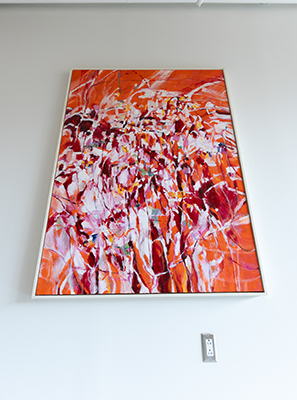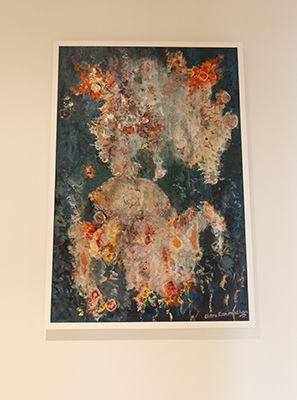
Aug 15, 2025 Accountancy Alumni Business Administration Faculty Finance Student
Wymer Hall brings new artworks to the university community
“It is the glory and good of Art
That Art remains the one way possible
Of speaking truth. . . .”
– Robert Browning
Steven S. Wymer Hall, the new educational facility on the campus of the University of Illinois Urbana-Champaign, will bring more than leading-edge educational technology to campus. It will also bring new artwork to the community to inspire, uplift, and engage the university and Gies Business community.
Funding for these art pieces was provided through the university’s Art in Architecture Policy, which sets aside a portion of the construction budget to be used to place works of art at the project site. The guidelines allow a wide variety of “creative works that reflect form, beauty and aesthetic proportions.” Additional funding for artwork in Wymer Hall was also provided through the John Chester Estate Endowment.
Wymer Hall will feature works by three distinguished artists, providing several paintings and a major sculptural installation.
Kana Tanaka
Artwork:
- Moment of Tranquility – Levels 1 and 2
Kana Tanaka, the artist behind the suspended glass installation in the main entryway of Wymer Hall, is a Japanese-born glass artist. Now residing in the San Francisco Bay Area, she seeks to inspire curiosity and exploration through the interplay of glass and light. She received her undergraduate degree in arts and crafts from the National Aichi University of Education in Japan and a Master of Fine Arts from the Rhode Island School of Design.
In Moment of Tranquility, the title of her artwork, Tanaka seeks to bridge her Japanese heritage – represented on campus in the Japan House – with an early visit to the University of Illinois during her student years.
“I wanted to begin my creative exploration with this particular landscape – so flat, with the sun rising and setting directly on the horizon – and to capture how different the daylight feels compared to where I grew up in Japan or where I live now in the Bay Area,” she said. “Sunlight was one thing I knew I wanted to use. And with the glass I bring, the sunlight creates the magic.”
Inspired by Japan’s national flower and the springtime cherry blossoms found at Japan House, Tanaka created 2,000 individual glass pieces shaped like the petals and leaves of the cherry tree. For her designs, 90 dichroic glass sheets were specially produced by a company in Southern California. Then, using her CAD designs for specific cherry petal and leaf shapes, the glass was precisely cut using waterjet technology in Portland, Oregon. Tanaka then hand-finished the pieces in her Northern California studio. She ground, shaped, drilled, kiln-fired, engraved, and polished each piece herself over six months.
Dichroic glass shifts in color depending on how the light interacts with it and from where it’s viewed.
“I wanted to introduce two base color groups to create shifting phases – two experiences from the same glass,” Tanaka explained. “This artwork captures a transitional moment in nature – the fleeting snowstorm of cherry blossoms, called Sakura Fubuki, as thousands of petals swirl in the wind, followed by the quiet emergence of fresh green leaves reaching toward the sky.”
Tanaka aims to create a unique emotional and visual experience for each viewer – one that evolves with light and time. On overcast days, the colors remain quiet and subdued. But when sunlight streams through the skylight, vibrant reflections of petals and leaves are projected across the surrounding walls and ceilings – sometimes even reaching deep into adjacent classrooms – while deeper, more saturated shadows spread across the floors and lower walls.
“My intention was to offer a space where students, who are often emerging from intense, analytical coursework, could briefly step away from that mental focus,” she said. “By immersing themselves in the surrounding light and color, they might momentarily forget the pressure and experience a quiet sense of refreshment – something simple, outside the usual demands of their day.”
Because the experience changes with the time of day and the variability of weather, these moments can be fleeting.
“The most vivid effects created by direct sunlight usually appear from morning to midday,” she said. “In this region, the weather shifts quickly, and even in summer, long stretches of sunlight aren’t guaranteed. Sometimes the light appears only briefly before clouds move in.”
She hopes this element of unpredictability and surprise will continue to engage and move visitors over time.
Reflecting on the process of developing this installation, Tanaka said, “It’s been a long journey – from the initial application to site visits, historical and geographical research, and interviews with people both within and beyond the university community. I created physical models to understand the architecture and collaborated with a CG designer to study how sunlight moves through the skylights and interacts with the space. I wanted to absorb everything – every layer that resonated with me – in order to bring the installation to life in a way that felt authentic to this place.
“For over two years – 28 months – I kept envisioning this space: flooded with light from five skylights, curved walls and a stairway anchoring the environment, and my glass petals and leaves suspended in midair, coexisting as if they’d always belonged. When I finally arrived on site for the installation, it was deeply moving. To stand under the real skylights I had imagined for so long, and to watch sunlight filter through them, igniting shimmering reflections from the dichroic glass – that moment was both surreal and like returning to a dream made real.”
Pooja Pittie

Artwork:
- A Way Between Voice and Presence – Level 2
- Before Today and Tomorrow (right) – Level 2
- Gathering Stillness – Level 3
- If There Were Another World – Level 4
Raised in Mumbai, India, Pooja Pittie is a self-taught visual artist based in Chicago, whose work explores the complex interplay between body and mind, movement, and stillness. She was trained as an accountant, earned an MBA from the University of Chicago, and spent several years in the corporate world before focusing full-time on her art in 2016. Pittie is living with a progressive form of muscular dystrophy, an experience that informs her work as she explores the dynamics of a slowing body together with an active, curious mind.
“I didn't come to art in the traditional way of going to art school,” said Pittie. “I thought about going to art school at various points in my life, but I think I didn't have the courage to make that change.”
Her diagnosis was the motivator to make this change. “It just made me question what I'm doing with my life. So, it just gave me this perspective on, what do I really want?” She decided that she wanted to focus on an art practice. Since making this change, she’s realized “It's just something I'm meant to be doing.”
“I don't like to categorize my art,” Pittie said of her work. “I know my paintings are abstract, so being an abstract artist or an abstractionist is important to me. I don't want people to take literal meanings from what I'm expressing. I want this to be more open.”
She believes her style helps to pull in the viewer to engage with the artwork.
“I do tend to use bright, vibrant colors, so I feel like that's a way for people to connect to the work, even if they're just quickly going past it. At first glance, they might find something in the colors that reflects an emotion or experience they're having. My paintings are often layered. So, if you see them from afar, you probably have a different experience than if you come close, and that drawing people in closer to look is my way of slowing people down and asking them to just be present in the moment.”
Chitra Ramanathan

Artwork:
- Pulsating Rhythms – Level 2
- Manifestation (right) – Level 3
Born and raised in in Kolkata (formerly Calcutta), India, Chitra Ramanathan has been involved in art from a young age. She was 11 years old when the Birla Academy of Arts and Culture in Kolkata showcased several of her entries, with a trophy award for one of the watercolor paintings. The previous year, she had been recognized as one of the top winners in a nationally announced child art coloring competition hosted by Unilever India and judged by a famed jury panel. The colorful costumes and festivals of India have always inspired her work.
Chitra received her bachelor’s degree in fine arts from the University of Madras in Chennai, India. She then moved to the United States and currently lives and teaches art in Atlanta. She is also a University of Illinois alumna, earning a second bachelor’s degree in painting in1993 from the College of Fine and Applied Arts, School of Art and Design, and an MBA from Gies College of Business in 1997.
“When beginning a painting, my approach is largely intuitional, but with a basic idea for a concept to develop into,” she said. “The initial inspiration often varies, either through visual references – such as photographs from travel experiences, as an example – or just purely mental impressions of nonvisual recollections, such as the melody in music, fantasy, dreams, often films, and the colorful costumes and festivals of India, which have remained in memory.
“Although the overall concept of my work is a thematic series, the content often varies in each piece. As a result, it can be a singular influence on one painting such as a conceptual abstract landscape, or a combination of different thoughts woven together into a story of pure fantasy on another piece, as in the two examples that have been selected from my portfolio for Wymer Hall.”
Ramanathan described how she created her frequent large-scale paintings: “In Pulsating Rhythms, I used both basic as well as heavy-body acrylic colors along with textural materials incorporated into the paints. On this large surface, I compare the panorama of undulating rhythmic movements and sound of ocean waves inspired by the Atlantic Ocean situated across from my former coastal home, to the aural experience of the rhythm in music, as a connection between my visual and mental interpretation. The piece titled Manifestation, on the other hand, is entirely conceptual. Employing a bold color palette and collaged mixed media, the subject is an abstract manifestation of a mythical entity, which I leave open to viewer impression.”
Ramanathan hopes the pieces draw positive responses: “I hope for my audience to derive happy visual responses through the colors, details and story told in these different pieces.”
